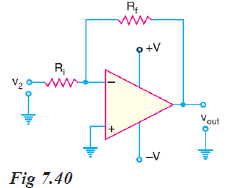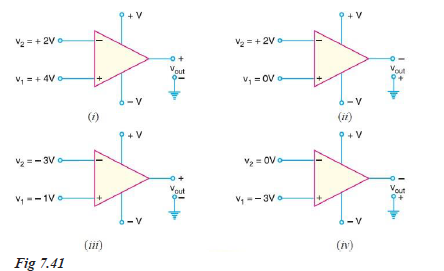1.
Voltage gain of OP-amp: The maximum possible voltage gain from a given OP-amp is called open-loop voltage gain and is denoted by the symbol A
OL. The value of A
OL for an OP-amp is generally greater than 10,000.
- The term =open-loop‘ indicates a circuit condition where there is no feedback path from the output to the input of OP-amp. The OP-amps are almost always operated with negative feedback i.e., a part of the output signal is fed back in phase opposition to the input. Such a condition is illustrated in Fig. 7.40. Here R
i is the input resistance and Rf is the feedback resistor. Consequently, the voltage gain of OP amplifier is reduced.

- When a feedback path is present such as Rf connection in Fig. 7.40, the resulting circuit gain is referred to as closed-loop voltage gain (A
CL). The following points may be noted:
(i) The maximum voltage gain of given OP-amp is A
OL. Its value is generally greater than 10,000.
(ii) The actual gain (A
CL) of an OP-amplifier is reduced when negative feedback path exists between output and input.
2.
OP-Amp Input/Output Polarity Relationship: The polarity relationship between v
1 and v
2 will determine whether the OP-amp output voltage polarity is positive or negative. There is an easy method for it. We know the differential input voltage v
in is the difference between the non-inverting input (v
1) and inverting input (v
2) i.e., v
in = v
1 – v
2- When the result of this equation is positive, the OP-amp output voltage will be positive. When the result of this equation is negative, the output voltage will be negative.
- Illustration. Let us illustrate OP-Amp input/output polarity relationship with numerical values.
(i) In Fig. 7.41(i), v
1 = + 4V and v
2 = + 2V so that v
in = v
1 – v
2 = (+ 4V) – (+ 2V) = 2V. Since v
in is positive, the OP-amp output voltage will be positive.

(i) In Fig. 7.41 (ii), v
1 = 0V and v
2 = + 2V so that v
in = v
1 – v
2 = (0V) – (+2V) = –2V. Since v
in is negative, the OP-amp output voltage will be negative.
(ii) In Fig. 7.41 (iii), v
1 = –1V and v
2 = –3V so that v
in = v
1 – v
2 = (–1V) – (–3V) = 2V. Clearly, the OP- amp output voltage will be positive.
(iii) In Fig. 7.41 (iv), v
1 = –3V and v
2 = 0V so that v
in = v
1 – v
2 = (–3V) – (0V) = –3V. Therefore, the OP-amp output voltage will be negative.
3. Supply Voltages. The supply voltages for an OP-amp are normally equal in magnitude and opposite in sign e.g., ± 15V, ± 12V, ± 18V. These supply voltages determine the limits of output voltage of OP-amp. - These limits, known as saturation voltages, are generally given by;
+ Vsat = + Vsupply – 2V
– Vsat = – Vsupply + 2V
- Suppose an OP-amplifier has Vsupply = ± 15V and open-loop voltage gain AOL = 20,000. Let us find the differential voltage vin to avoid saturation.

- If the differential input voltage V
in exceeds this value in an OP-amp, it will be driven into saturation and the device will become non-linear.
Note: Although input terminals of an OP-amp are labeled as + and –, this does not mean you have to apply positive voltages to the + terminal and negative voltages to the –terminal. Any voltages can be applied to either terminal. The true meaning of the input terminal labels (+ and –) is that a positive voltage applied to the + terminal drives the output voltage towards +V of d.c. supply; a positive voltage applied to the – terminal drives the output voltage towards –V of d.c. supply.
Wilfykil answered the question on
August 16, 2019 at 08:51